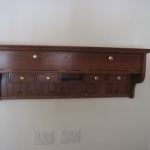I am building a new shop alonside my home. It,s 1300 sp ft, built on slab. The new shop has been a long time coming but many years ago the company that installed the septic for the house installed a second main line pointed in the direction I knew the shop was going to be built in.I dug it up to see how deep and what size it was. It’s 4″, buried 38″ down. I have about 86′ from the toilet in the shop to the hook up. Not being a plumber but a finish carpenter, my question is “at what height should I come into the foundation?
Discussion Forum
Discussion Forum
Up Next
Video Shorts
Featured Story

The end of this program will likely lead to higher energy bills and fewer business opportunities for the American people.
Highlights
"I have learned so much thanks to the searchable articles on the FHB website. I can confidently say that I expect to be a life-long subscriber." - M.K.
Fine Homebuilding Magazine
- Home Group
- Antique Trader
- Arts & Crafts Homes
- Bank Note Reporter
- Cabin Life
- Cuisine at Home
- Fine Gardening
- Fine Woodworking
- Green Building Advisor
- Garden Gate
- Horticulture
- Keep Craft Alive
- Log Home Living
- Military Trader/Vehicles
- Numismatic News
- Numismaster
- Old Cars Weekly
- Old House Journal
- Period Homes
- Popular Woodworking
- Script
- ShopNotes
- Sports Collectors Digest
- Threads
- Timber Home Living
- Traditional Building
- Woodsmith
- World Coin News
- Writer's Digest



















Replies
I'm not a plumber, nor do I play one on TV, and someone will no doubt come along and explain how stupid my answer is, but until then, for pre-planning purposes only:
You generaly want a slope of about 1/4" to the foot for inside (and hence relatively short) runs, but I believe for longer runs you can go to about 1/8" to the foot, or maybe a little shallower. You do want to avoid steep slopes (which I'd guess means rougly over 1/2" to the foot) as they can cause the water to "outrun" solids rather than helping the solids along. 1/8 inch slope over 86 feet would mean the line should be about 12.5" higher on the shop end than at your connection.
You do, of course, want to keep everything below the frost line.
exterior soil piping
There is no need to install the soil pipe below the frost line, in most cases, and, the elevation of the soil pipe is determined by the septic tank inlet.............
No need if you don't mind the line getting frozen solid.
Not such a big issue for a household drain that is used regularly, but something like a shop may not be used for days or even weeks at a time, especially in bitterly cold weather. Add to that a very slight leak in the toilet and you have a drain line frozen solid.
??
I don't know where you live, but the frost line here is 42", and they do not determine the septic tank location, or elevation, based on the frost line. Many tanks are two to three feet below grade, which puts the soil pipe generaly one to two feet below grade where it enters the house, and, I have seen scores of main waste pipes exit the foundation ( or slab in many cases ) just inches below grade.
The break down of organic matter that occurs in active tanks, generates some heat which will travel back through the soil pipe as waste water flows into the tank. There can be problems with exposed piping ( including unheated garages, etc. ), as you have pointed out, when there is a slow, continuous leak; this can result in a frozen solid soil pipe - it is not a common occurrence. Those that have experienced this, have learned to keep their plumbing system in proper repair, and in the case of " snow birds ", who spend the winter in warmer climates, many opt ( or should opt ) to shut off the main water supply while they are away..............
Well, a lot of people around here (42" as well) have had their septic tanks freeze this winter.
It's all kind of moot, isn't it?
The depth of a waste line is determined by the elevation of the tank inlet, the distance of the run, and the required pitch. It might or might not end up below frost line. DanH's point about a seldom used line potentially freezing is a good one, but I've installed dozens of septics in houses with no problem where the line was not below frost depth. One idea that would help is to insulate directly above the line with 2 in. rigid foam.
Leach field.
I would assume that the leach field or seapage pit would have to be well below the frost line. I can't imagine a leach line leaching very well into frozen ground, but I guess that's why I live in South Calif. so I don't have to imagine this kind of stuff.
Nope.
Usually, there's only a foot or so of cover on a leach field. That's all included in the engineer's design, and I've been told that evaporation is factored in to the field's capacity. Keep in mind that the bio-activity in the system warms things up considerably. I've seen bare grass over my septic tank with a foot of snow on other parts of the lawn.
Andy,
You are correct, certain septic system designs include surface evaporation. I've located dozens of " lost " septic tanks by looking for an outline during, and after a light snowfall. I have also had success locating tanks by dowsing.........
Don't worry about freezing
Maintain a minimum 1/4" per foot, or for easy math 2% pitch. No more than 15% pitch or the liquid will run away and leave the solids. Modern toilets only have 1.6 gallons of water or( ~13.34 pounds of force) to push the solids to the tank. Use nothing smaller than 4" diameter pipe. Dont' worry about the frost line. If you compact the soil under the pipe and carefully dig (not over dig then fill) you will maintain a steady flow to the septic tank and there will be no standing water left to freeze in the pipe. The only time the material in that pipe will freeze if : 1) There is a belly sag in the pipe. 2) if the leach field has failed and won't take any more waste water ,therfore allowing standing water back up into the pipe. or 3) Some one (say a child or elderly person) uses an inordinate amount of toilet paper and causes a clog in the tank at the inlet baffle. Over the last 15 years I have installed over 300 septic tanks here in New Hampshire and most of the pipes are gravity flow and installed above frostline. The only frozen wastewater pipes I have ever seen, were from circumstances described above. I hope this helps. Best wishes with your project.